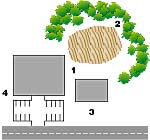Site Selection

Study Sites and Stations
A study site is a location that is monitored. This site can be an individual's backyard, the school
grounds, or a favorite park. A station is a location within the study site that is visited to make and record
observations.
Habitats
Wildlife use different habitats during the day or seasonally. Some species will be found in specific habitats (i.e., wetlands),
while others may use multiple habitats. The size of the habitat is also an important variable. Habitats can be as
small as a little puddle or as large as a city. It often helps to look at the bigger picture in order to determine habitats.
For example, if you see a bird in a tree, is the tree in a forest or in your backyard?
A forest bird may not use a plot of 10 trees, even if the trees are the same size and type the bird would use in the forest.
The plot of 10 trees would become a component of the dominant habitat, which could be an urban backyard.
NatureMapping looks at habitats the size of football fields or larger. Any habitat that is smaller than the size of a football field will be included in the dominant habitat surrounding it.
Habitats the Size of Football Fields or Larger
 This
example has 3 distinct habitats (524-pond, 221-moderate developed, 225-developed grass) that are as large or larger than
a football field:
the highly developed building site, grass playing field, and a small pond
surrounded by conifer trees. The exception would be the pond. It does not have to
be as large as a football field, because it is a distinct habitat used exclusively
by many forms of wildlife. This
example has 3 distinct habitats (524-pond, 221-moderate developed, 225-developed grass) that are as large or larger than
a football field:
the highly developed building site, grass playing field, and a small pond
surrounded by conifer trees. The exception would be the pond. It does not have to
be as large as a football field, because it is a distinct habitat used exclusively
by many forms of wildlife.
For this example, each site would have stations for consistent data collection. For example,
Stations 1 and 2 would monitor species around the buildings (habitat 221). Station 3 would monitor the entire wetland
site (habitat 524). Stations 4 and 5 would monitor the open grass (habitat 225).
Smaller Habitats
 If the site has habitats that are smaller than a football field, then the
habitats are grouped into the primary habitat, which in
this example would be
a school or home. Stations would be set up throughout the property, but there
would be
only one habitat recorded. If the site has habitats that are smaller than a football field, then the
habitats are grouped into the primary habitat, which in
this example would be
a school or home. Stations would be set up throughout the property, but there
would be
only one habitat recorded.
The habitat code for the entire site would be dependent on the neighborhood.
For this example, we will use 231
(Developed = 2, Light = 3, Residential = 1).

Recording
Remember that stations are simply selected locations for consistent observation of a habitat.
In the
two examples being discussed, if the same species were observed at:
- Stations 1 and 2 in the first example (larger habitats)
on the same day,
the largest number of individuals would be recorded, not added together.
- At all the stations in the second example (smaller habitat) on the same day,
the largest number of individuals would be recorded, not added together.
Birds move around and it is very likely that observers in both examples saw the same birds.
EXAMPLE: Larger Habitat/10 am/15 min. Observation
- Station 1
- 9 American crows
1 Bald eagle flying overhead
3 Dark-eyed juncos
- Station 2
- 8 American crows
6 Dark-eyed juncos
- Recording: : Habitat 221 (Stations 1 & 2 combined)
- 9 American crows
1 Bald eagle
6 Dark-eyed juncos
If American crows were observed in the developed area and also observed on the grass,
would you record the crows in both habitats, even if they were the same crows?
The answer is yes, if you want to learn about the different habitats that wildlife
use. If you are not monitoring the habitat, then you don't need to separate out
the same crows on the NatureMapping Data Collection Form. Use the habitat code where you saw the most crows. The location
(Township/Range/Section) will be sufficient.
Wildlife home >
| 


